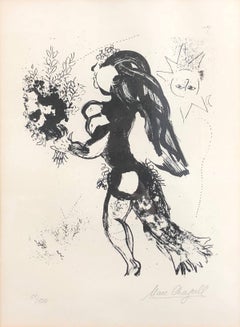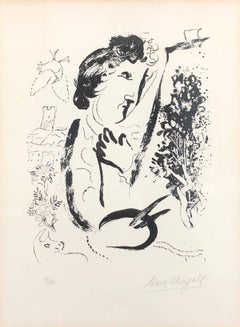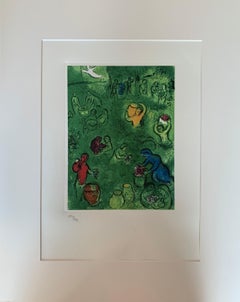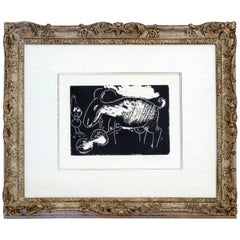Marc Chagall Numbered Print
L'Offrande (Signed and Numbered)
By Marc Chagall
Located in Missouri, MO
Lithograph on Arches Paper
Pencil Signed Lower Right, "Marc Chagall"
Numbered Lower Left Ed. 51/100
Category
1960s Modern Figurative Prints
Materials
Lithograph
Devant le Tableau (Signed and Numbered)
By Marc Chagall
Located in Missouri, MO
Lithograph on Arches Paper
Pencil Signed Lower Right, "Marc Chagall"
Numbered Lower Left Ed. 9/40
Category
1960s Modern Figurative Prints
Materials
Lithograph
Lovers with a Rooster - Lithograph, Numbered / 500
By Marc Chagall
Located in Paris, IDF
Marc CHAGALL
Lovers with a Rooster
Lithograph and stencil (Jacomet workshop)
Printed signature in
Category
1960s Modern Figurative Prints
Materials
Lithograph, Stencil
Daphnis & Chloé - Original Lithograph - platesigned - numbered
By (after) Marc Chagall
Located in Sint-Truiden, BE
Marc Chagall (1887-1985) (after) - Cycle Daphné & Chloé
Original lithograph
Print 131/333 copies
Category
20th Century Surrealist Figurative Prints
Materials
Lithograph
$753 Sale Price
30% Off
H 20.48 in W 16.54 in D 0.4 in
Recent Sales
Marc Chagall Serigraph 'Blue Violinist', Facsimile Signed, Numbered and Framed
By Marc Chagall
Located in Plainview, NY
The "Blue Violinist" serigraph by Marc Chagall ( Russian-French 1887–1985) was a is a vibrant
Category
20th Century Surrealist Figurative Prints
Materials
Paper
Ziege Mit Geige a Framed Woodcut by Marc Chagall Signed and Numbered 12/20
By Marc Chagall
Located in Keego Harbor, MI
For your consideration is a spectacular, framed woodcut, "Ziege mit Geige," signed by Marc Chagall
Category
Vintage 1920s Prints
Materials
Paper
They were in Forty Pairs, Thus Numbering Fourscore
By Marc Chagall
Located in OPOLE, PL
This work will be exhibited at Art on Paper NYC, September 4–7, 2025.
–-
Marc Chagall (1887-1985
Category
1940s Modern Figurative Prints
Materials
Lithograph
UNTITLED FROM XXe SIECLE (MOURLOT 699)
By Marc Chagall
Located in Aventura, FL
Marc Chagall. Printed by Mourlot, Paris. Published by XXe Siècle, Paris. Printed for the special
Category
1970s Surrealist Figurative Prints
Materials
Paper, Lithograph
Marc Chagall, Color Lithograph from Ur Derriere Le Miroir Number 256
By Marc Chagall
Located in New York, NY
Marc Chagall (1887-1985)
Color lithograph
"Ur Derriere le Miroir" no. 256
(From behind the
Category
Vintage 1980s French Prints
Materials
Paper
De Mauvais Suject Framed Lithograph by Marc Chagall Signed and Numbered 9/112
By Marc Chagall
Located in Keego Harbor, MI
Marc Chagall, numbered 9/112. In excellent condition. The dimensions of the frame are 19" W x 24" H
Category
20th Century Prints
Materials
Paper
H 24 in W 19 in D 1.5 in
Chagall Print Le Coq Avec Le Bouquet Jaune Signed and Numbered Limited Edition
By Marc Chagall
Located in Hopewell, NJ
edition print by Marc Chagall (Russian/French, 1887-1985)
# 18/500 limited edition, signed by the artist
Category
20th Century French Prints
Materials
Paper
H 35 in W 29.5 in D 1.75 in
Le Clown Amoureux (Pencil Signed and Numbered)
By Marc Chagall
Located in Missouri, MO
Lithograph on Arches Paper
Pencil Signed Lower Right, "Marc Chagall"
Numbered Lower Left Ed. 24/40
Category
1960s Modern Figurative Prints
Materials
Lithograph
Elsa Triolet, Woman With a Bird - Original Lithograph Hand Signed & Numbered
By Marc Chagall
Located in Paris, IDF
Marc Chagall
Elsa Triolet, Woman with a bird
Original lithograph, 1972
Hand signed in pencil "89
Category
1970s Modern Figurative Prints
Materials
Lithograph
Angel and Child - Lithograph Hand Signed & Numbered /100 - Terre des hommes
By Marc Chagall
Located in Paris, IDF
Marc Chagall
Angel and child
Lithograph in colors, 1972
Hand signed in pencil
Numbered /100
Category
1970s Modern Figurative Prints
Materials
Lithograph
Arabian Nights - Original Lithograph - platesigned - numbered
By (after) Marc Chagall
Located in Sint-Truiden, BE
Marc Chagall (1887-1985) (after) - Arabian Nights
Original lithograph
Print 141/333 copies, from
Category
20th Century Surrealist Figurative Prints
Materials
Lithograph
H 20.48 in W 16.54 in D 0.4 in
Le joueur de flute - Original Lithograph - platesigned - numbered
By (after) Marc Chagall
Located in Sint-Truiden, BE
Marc Chagall (1887-1985) (after) - “Le joueur de flûte”
Lithograph signed in the plate
Numbered
Category
20th Century Surrealist Figurative Prints
Materials
Lithograph
H 19.69 in W 15.75 in D 0.04 in
Marc Chagall "Moses Shows The Elders The Tablets Of The Law" Numbered Lithograph
By (after) Marc Chagall
Located in Gallatin, TN
(After) Marc Chagall Lithograph Titled "Moses Shows The Elders The Tablets Of The Law. This
Category
20th Century Post-Impressionist Figurative Prints
Materials
Lithograph
People Also Browsed
"Pietra" Curved Armchair with Leather Arms Upholstered in Bouclé Fabric
By Studio Marta Manente
Located in Centro, RS
Pietra from Italian: Stone
The designer Marta Manente is of Italian descent, her great-grandparents migrated from Italy over 100 years ago and lived in the region of Bento Gonçalves ...
Category
21st Century and Contemporary Brazilian Modern Armchairs
Materials
Bouclé
$3,969 / item
H 28.35 in W 40.16 in D 34.65 in
Loetz Art Nouveau Four Handled Phaenomen Iridescent Art Glass Vase
By Loetz Glass
Located in Bishop's Stortford, Hertfordshire
An exceptional and rare Bohemian art nouveau Phenomen Genre 2/484 (also known as Medici) pattern Loetz vase dating from around 1902. This beautiful vase stands on a rounded spread fo...
Category
Antique Early 1900s Austrian Art Nouveau Vases
Materials
Blown Glass
Son Abrines
By Joan Miró
Located in San Francisco, CA
"Son Abrines" Original etching with aquatint printed on Guarro paper. Ink stamp signed, numbered 23/75 in pencil. Also hand signed in pencil on the back by the grand son of the artis...
Category
1980s Abstract Abstract Prints
Materials
Aquatint
MARC CHAGALL "DAY BREAK - 1983"
By Marc Chagall
Located in Pembroke Pines, FL
MARC CHAGALL (1887-1985)
"Day Break"
lithograph in colours, 1983, on wove paper.
Signed in pencil, Numbered 26/50 in pencil
21.5 x 17 Inches.
LITERATURE: Mourlot 1014
CONDITION: Exce...
Category
1980s Contemporary Figurative Prints
Materials
Lithograph
Marc Chagall, Femme à l’oiseau, Lithograph, 1959
By Marc Chagall
Located in Chatsworth, CA
Marc Chagall
Femme à l’oiseau
Lithograph in colors
Numbered 872/970 from the edition of 970
Signed in the plate
From "Douze Contemporains" by Jacques Lassaigne and published by Editi...
Category
1950s Modern Portrait Prints
Materials
Lithograph
$1,264 Sale Price
48% Off
H 12.75 in W 18 in
Josef Hoffmann and the Wiener Werkstaette Fabric Department Pendant, Re-Edition
By Woka Lamps, Wiener Werkstätte, Josef Hoffmann
Located in Vienna, AT
A simple but sensational fixture, designed by Josef Hoffmann, for the fabric department of the Wiener Werkstaette on Kaerntnerstrasse in Vienna. Style and color of the fabric custom-...
Category
2010s Austrian Jugendstil Chandeliers and Pendants
Materials
Silk
$6,462 / item
H 39.38 in Dm 37.41 in
Miro Lithographe II Plate III
By Joan Miró
Located in Washington, DC
Artist: Joan Miro
Medium: Original lithograph
Title: Miro Lithographe II, Plate III
Portfolio: Joan Miro Lithographe II
Year: 1975
Edition: Unnumbered
Framed Size: 20 1/2" x 27 1/2" ...
Category
1970s Abstract Prints
Materials
Lithograph
Joseph and his brothers - Lithograph by Marc Chagall - 1978
By Marc Chagall
Located in Roma, IT
Joseph and his brothers is a contemporary artwork realized by Marc Chagall in 1978.
Mixed colored lithograph.
Image dimensions: cm 36.5x30
Hand Signed and numbered in pencil 25/50...
Category
1970s Surrealist Figurative Prints
Materials
Lithograph
$12,565
H 23.51 in W 18.12 in D 0.04 in
Venetian Modern Octagonal Mirror with Brass Details
Located in Barcelona, ES
Venetian Modern Octagonal Mirror with Mirror and Brass Frame
Venetian style octagonal wall mirror with gilt metal accents, Spain, 1950s
This octagonal mirror has a triple mirror fram...
Category
20th Century Spanish Mid-Century Modern Wall Mirrors
Materials
Brass
Joan Miro Lithograph Titled "Miro Sculptor Japan, " Signed and Numbered
By Joan Miró
Located in New York, NY
This is a Joan Miro lithograph. Titled: Miro Sculptor Japan. It was a print exclusively for Collector's Guild members. Signed in the stone. Numbered 2/1000 in pencil. Framed measures...
Category
Vintage 1970s Spanish Mid-Century Modern Prints
Materials
Paper
$3,500
H 13.75 in W 21.75 in D 1 in
Vitraux pour Jérusalem - Illustrated Book by M. Chagall, 1962
By Marc Chagall
Located in Roma, IT
"Vitraux pour Jerusalem" is one of the most important books illustrated by Marc Chagall and considered as one of his editorial masterpieces.
The complete deluxe, signed edition, wit...
Category
1960s Surrealist More Art
Materials
Paper, Lithograph
$29,918
H 11.03 in W 14.18 in D 1.19 in
Plate VI, from Joan Miro by Jacques Prévert and Georges Ribemont-Dessaignes
By Joan Miró
Located in Collonge Bellerive, Geneve, CH
Plate VI, from Joan Miro by Jacques Prévert and Georges Ribemont-Dessaignes, a book published by Maeght and Printed by Mourlot in 1956.
Reference: Mourlot 237
Unknown publication s...
Category
1950s Abstract Abstract Prints
Materials
Lithograph
$1,555
H 9.06 in W 7.88 in D 0.04 in
Marc Chagall - The Candlestick - Original Lithograph
By Marc Chagall
Located in Collonge Bellerive, Geneve, CH
The Candlestick, from Jean Leymarie, Vitraux pour Jérusalem (Jerusalem Windows), André Sauret, Monte Carlo, 1962 (see M. 366-72; see C. books 55). Unsigned and unnumbered, as issue...
Category
1960s Surrealist Figurative Prints
Materials
Lithograph
$2,513
H 12.8 in W 9.65 in D 0.04 in
Chandelier Brass in the Manner of Dagobert Peche Wiener Werkstätte, Austria 1910
By Dagobert Peche, Wiener Werkstätte
Located in Vienna, AT
Chandelier of solid brass in the manner of Dagobert Peche and Wiener Werkstätte, Austria around 1910. It impressively shows how various new signs and languages of form were sought an...
Category
Vintage 1910s Austrian Art Deco Chandeliers and Pendants
Materials
Brass
$3,829
H 28.35 in Dm 29.53 in
Bold Abstract Circles Color Lithograph Alexander Calder Unfinished Revolution
By Alexander Calder
Located in Surfside, FL
1975 Color Lithograph by Alexander Calder
from Our Unfinished Revolution portfolio
One of 250 copies, with the printed signature and date on offset paper.
This is not pencil signed ...
Category
1970s American Modern Abstract Prints
Materials
Lithograph, Offset
19thC English Prep Table
Located in Staffordshire, GB
Circa 1880
19thC English prep table with bleached scrubbed top and two drawers
Original hardware
Measures: W 215 x D 70 x H 76 cm.
Category
Antique Late 19th Century British Industrial and Work Tables
Materials
Pine
Get Updated with New Arrivals
Save "Marc Chagall Numbered Print", and we’ll notify you when there are new listings in this category.
Marc Chagall Numbered Print For Sale on 1stDibs
You are likely to find exactly the marc chagall numbered print you’re looking for on 1stDibs, as there is a broad range for sale. In our selection of items, you can find Surrealist examples as well as a Modern version. If you’re looking for a marc chagall numbered print from a specific time period, our collection is diverse and broad-ranging, and you’ll find at least one that dates back to the 20th Century while another version may have been produced as recently as the 20th Century. When looking for the right marc chagall numbered print for your space, you can search on 1stDibs by color — popular works were created in bold and neutral palettes with elements of gray, beige, white and brown. Creating a marc chagall numbered print has been a part of the legacy of many artists, but those crafted by Marc Chagall and (after) Marc Chagall are consistently popular. Artworks like these of any era or style can make for thoughtful decor in any space, but a selection from our variety of those made in lithograph can add an especially memorable touch.
How Much is a Marc Chagall Numbered Print?
The average selling price for a marc chagall numbered print we offer is $3,426, while they’re typically $800 on the low end and $35,000 for the highest priced.




